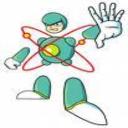PHYS 1023 Study Guide - Midterm Guide: Alpha Particle, Acute Radiation Syndrome, Point Particle
54 views4 pages
24 Aug 2016
School
Department
Course
Professor
Document Summary
Chapter 6 conservation of energy: you can"t get ahead. Industrial revolution: the onset of the fossil-fueled industrial age, around 1750. Work: object a does work on object b if a exerts a force on b while b moves in the direction of that force. The energy of a system is the amount of work the system can do. Gravitational energy: energy due to gravitational forces. Elastic energy: energy due to the ability of a deformed system to snap back. Equability, thermal energy is microscopic energy, the kinetic (and other) energy of molecules that cannot be directly observed macroscopically. Electromagnetic energy: the energy that an electrically charged object has due to its position in an electromagnetic field. Radiant energy: energy carried by an electromagnetic wave. Nuclear energy: the energy resulting from the structure of a material"s nuclei. Calorie: the amount of work (or energy) needed to raise the temperature of 1 kilogram of water by 1 degree celsius.






